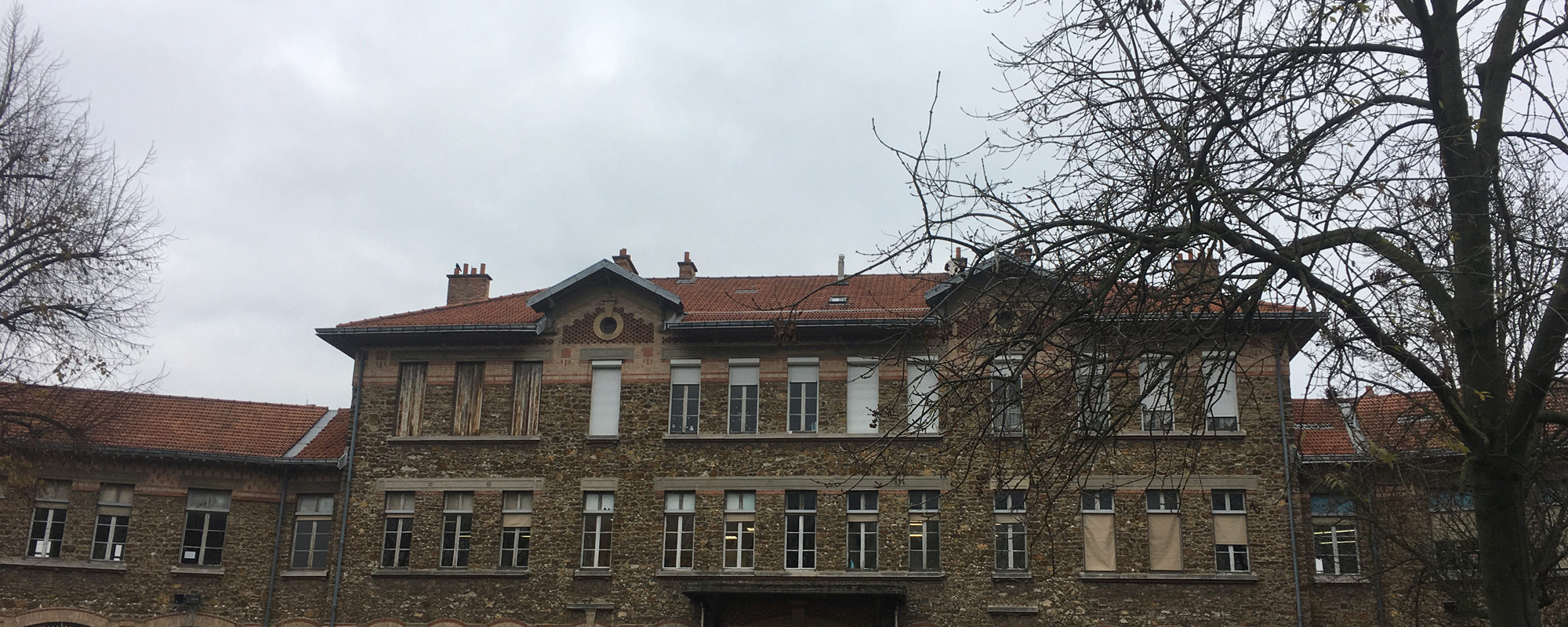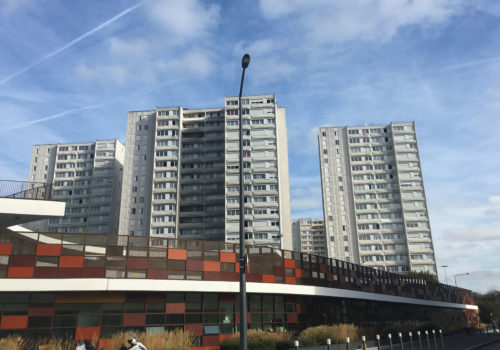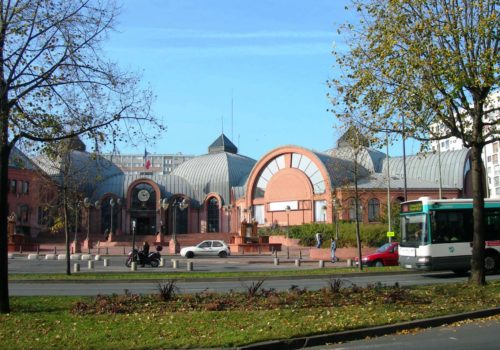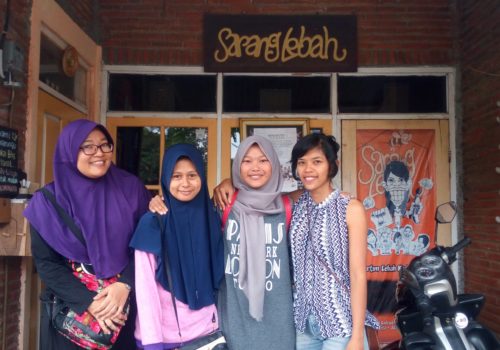VITRY-SUR-SEINE, France — Romain Geffrouais rearranges the desks in his classroom at the Lycée Adolphe Cherioux, a high school in this Paris suburb, where he teaches history and geography. He pushes them toward the edges of the room in a large circle, placing four in the center. His students move the chairs around to accommodate the new configuration. On the wall hangs a poster of Youssoupha, a French rapper from Kinshasa, in the Democratic Republic of Congo. A piece of paper with a large eye and the warning “The cleaning lady is watching you,” is taped to a dresser in the back of room.
The teenagers chat among themselves, but Geffrouais doesn’t want to waste any time: For the next hour, his classroom would house a simulated radio debate. Five students would adopt the personas of major figures in the national conversation on laïcité—the state policy of secularism—from those who loudly criticize the discriminatory manipulations of the concept to those who defend it to varying degrees. The debate centers on competing interpretations of laïcité, whether or not it’s in “crisis”—and if it is, why—and the difficulties of applying it in public schools. Geffrouais would play the talk-show host, and the remaining 25 students, acting as members of the public, could “call in” after the discussion to voice their opinions.
The debate is part of a pedagogy of laïcité that Geffrouais created in 2016 with several colleagues in response to what he deemed a “totally insane” institutional response to the massacre at Charlie Hebdo, in January 2015. The attack—committed by French nationals Saïd and Chérif Kouachi, brothers born in Paris—killed 12, including eight members of the publication’s editorial staff. Its symbolism was striking: Two men raised in the French system attacked a publication hailed by many as a beacon of freedom of expression. The incident brought new hysteria into an ongoing conversation about Islam in France.
Geffrouais, 31, has dark shaggy hair and an informal manner, and doesn’t seem too serious on first encounter. However, that impression fades when he starts talking about his cause. He speaks deliberately, and proudly proclaims that he believes in “the power of resistance.” Over coffees after his class, he recalls the tense atmosphere at his high school the morning after the attacks. Some students plastered the walls with posters expressing solidarity with the victims, summed up by the quickly internationalized slogan Je suis Charlie, or “I am Charlie.” Others, who, as Muslims, felt targeted by Charlie Hebdo’s satire, took them down, refusing to condone the outpouring of support for a magazine with an editorial line with which they disagreed.
In the days that followed, the media and government jumped on what ultimately amounted to only isolated instances in which some students refused to participate in a national “moment of silence.” And so government officials identified the problem: The school system’s failure to transmit republican, laïque values, a shortcoming in its duty to train citizens.
“The government reacted quickly, but without any reflection. Its first impulse was repression,” Geffrouais says, lamenting a push to “turn the school system into a weapon against terrorism.”
The first impulse is repression, Geffrouais says of the government, lamenting a push to “turn the school system into a weapon against terrorism.”
That response involved a series of measures to mobilize the school system against terrorism and for republican values, centered on laïcité. But as he saw it, linking the very real threat of radical Islamism to a problem with the teaching of laïcité in public schools, especially those with large Muslim student populations, was a flawed reading of the situation.
It’s from there—a “misdiagnosis,” Geffrouais says—that the Education Ministry encouraged teachers to double down on laïcité and republican values. “It’s exactly what I never do in my classroom: preach,” he says emphatically. Worse, the government’s vision of laïcité, under the tutelage of then-Prime Minister Manuel Valls, was narrow and anti-religious. (Valls has since found himself at the center of numerous controversies over the manipulation of laïcité, from his enduring defense of a “burkini ban” last summer while he was still in office to recent statements that invoke the term demonizing Muslims).
“The government was asking me to impose a sort of republican morality on my students, when my job is to give them the ability to position themselves critically in relation to that narrative,” Geffrouais adds. He saw it as his responsibility as a teacher and activist to say that the government’s line was wrong.
“It’s called being a teenager”
Geffrouais grew up in the northwest region of Brittany, moved to Paris as a student and quickly found his place in Ivry-sur-Seine, a suburb that neighbors Vitry with similar demographics. “It’s important to me to live in the area where I teach,” he says proudly, adding that it’s also nice to have some distance, not to “run into students’ parents while throwing back a few beers.”
Schools have always been a central battleground in debates over laïcité in France, but the 2015 attacks dragged education policy into a national panic over homegrown terrorism. Geffrouais describes a climate in which his students, the majority of whom are Muslim and of North African descent, were portrayed as “dangerous.” He and his colleagues were instructed to identify students who could potentially be radicalized, with criteria including disrespectful attitudes and changes in behavior or clothing. “I said to myself, 98 percent of my students fit that description—it’s called being a teenager,” he says, laughing. One of his colleagues was fired after he organized a discussion with his students rather than have them participate in a moment of silence.

Geffrouais refused to go along with the orders from above. His students are well aware of their place in French society, he says—“discriminated against as racialized youth from the suburbs, of a minority religion, who experience Islamophobia in their daily lives”—a reality he didn’t want to perpetuate. He also disagrees with the government’s argument that examining the social and political drivers of radicalization—from economic inequality on religious and ethnic lines to France’s own involvement in wars in the Middle East—amounted to making “excuses” for terrorism.
So he explained to his students instead that terrorism didn’t appear in a vacuum. He discussed the history of Islamism as a political project, and the geopolitical conditions that gave rise to the jihadist groups Islamic State and al-Qaeda—expertise that he acknowledges most of his colleagues lack. “I started to be afraid that if someone were to find out about what I do as a teacher, I could lose my job—but all I was doing was refusing to oversimplify things with my students, refusing to ‘civilize’ them.”
He sought to cut through what he saw as the government’s faulty equivalence between a shortfall of laïcité and radicalization, partly with a vision of the former that wasn’t tantamount to asking students to “disengage from their religion, as if their beliefs were negative in and of themselves.” That meant finding a way to promote laïcité’s potential as a unifier, depoliticizing the concept and helping his students understand the forces that use it against them.
“It’s rare to see anyone—students, teachers, members of society—who are ‘against’ laïcité,” he says. “But it’s a question of what we put behind that word. And today, it’s all about Islam” and the place of Muslims as a permanent feature of French demographics.
Teaching teachers
Geffrouais has spent almost a decade teaching in establishments in poor areas and with significant Muslim populations. He used his experience to craft a new pedagogy on laïcité, working with the French Group for New Education. I attended a workshop he held in Ivry, where teachers from difficult schools paid 25 euros to learn about his approach. They went around the room sharing anecdotes, from a student who refused to enter a cathedral on a class outing to tensions about fasting during Ramadan, or eating pork, in the cafeteria. A woman in her early 30s expressed discomfort with what she saw as “institutional violence toward Muslim families since the attacks,” adding that her students assume that their teachers are all atheists, using “laïcité to imply that religion doesn’t exist at school, that we remove everything, our veils, our identity.”
Many said they recognized the importance of teaching laïcité, but didn’t know how—either because they were afraid to bring it up, fearing backlash from students, or because they simply weren’t knowledgeable enough.
Geffrouais has built a multipronged strategy to create a climate where he can broach the topic of laïcité in a way that’s transparent and open, helping his students situate French secularism in a global context and understand its history. “Some teachers are afraid to talk about laïcité or religion at all—they think their students will reject it. But that’s not true at all.”
I sat in on Geffrouais’s lessons. He teaches the history of laïcité, then moves to the contemporary debates, which he discusses frankly. In a subsequent class, he distributes constitutions from around the world—including Iran, Israel, Bhutan, Mexico and Ireland—and has his students identify phrases they found laïque, and others they didn’t, encouraging them to reflect on the question of church and state on a larger scale. That helps students recognize that although laïcité has a particular history in France, the concept’s core—a divorce between religion and politics—is inherent to democracy.
“Some teachers are afraid to talk about laïcité or religion at all—they think their students will reject it. But that’s not true at all.”
Geffroauis calls the following exercise “an island at the end of the world”—an imagined apocalyptic scenario in which a community of 500 people of diverse faiths and denominations is stranded on a desert island and must organize society. When the teachers at his workshop attempt to complete the exercise, they immediately clash over the calendar, places of worship and how to best educate children. In nearly every scenario, teachers in the workshop—and, he says, his students—end up designating a neutral space, a blank, that represents laïcité, which they often position against a multiculturalist scenario that many of them see as dangerous. At the workshop, the teachers all placed the island’s school in that neutral space.
After his students design their apocalyptic island, Geffrouais prepares them for the radio debate. Once that’s done, they write letters to the figures they had adopted—and even send them. Last year, he tells me, some actually responded. “The students realize they can participate in the national conversation, that they can make their voices heard.”
Geffrouais hopes that his new strategy will help students gain the critical-thinking skills necessary to challenge a concept that, at least in some corners of French politics and media, is being used against them. But he recognizes that he’s in the minority of teachers willing to develop a counter-narrative with his students—even among his colleagues. “We need to stop thinking that the Muslim religion is a problem, and that’s the position many of the other teachers here defend.”
But teachers don’t necessarily reject or shy away from his approach because they’re afraid of Muslims. Rather, they see themselves as government officials following orders. Others still are afraid to even mention the word laïcité, or discuss religion at all, either from fear of their students’ response—a testament to an uneasy, combative climate—or simply because they don’t feel sufficiently informed. And others yet, it seems, actively don’t want their students to think critically about how laïcité manifests itself in their lives. A teacher who works in a high school with a similar population to Geffrouais’s demonstratively rejected my request to distribute a questionnaire that invited her students to comment on the 2004 law banning religion symbols. “In the public school system, the laws of the Republic apply, the 2004 law and others,” she wrote by email. “The students thus can’t be questioned, within the walls of the school, on its very legitimacy.”
It’s that dogmatic adherence to institutional parameters that Geffrouais rejects, opting instead to cultivate his students’ trust. He recalls how, when students questioned the reasoning behind the moment of silence over Charlie Hebdo, then-Education Minister Najat Vallaud Belkacem called their challenges “intolerable.” “I said to myself no, on the contrary—this is the exact space for them to ask their questions, to challenge what they hear,” he tells me. “I’d rather they be provocative in the classroom, so I can work with them. That’s the mission we should have.”

Diverging views
Nearly everyone within the school system I’ve spoken to, from instructors to education professors to government officials, agrees that teachers need better training on laïcité—both in terms of expertise and in how they address the issue with students. But how teachers are trained and who trains them present yet more sources of tension. I mentioned Geffrouais’s views to Johnny Brousmiche, the referent laïcité at the teacher’s training academy in Paris, known by its French acronym ESPE. He called Geffrouais’s interpretation “problematic and unfounded.” His tone is measured but he’s clearly exasperated, both by my line of questioning and Geffrouais’s attitude. “Look at the legal texts, the laïcité charter—they present the minimum criteria necessary to coexist, and nothing more. I have trouble understanding by what sleight of hand someone could say otherwise.”
It’s little wonder Brousmiche was frustrated. That week, the ESPE was at the center of a controversy over the individuals it had selected—Georges Bensoussan and Philippe Val—to speak at a conference and workshop on laïcité. The former, a historian, author and editorial director of the Holocaust Museum in Paris, was sued—but not convicted—in 2015 for “inciting racial hatred,” a crime in France, for claiming that “In Arab families, in France, everyone knows but nobody wants to say it: anti-Semitism, it comes with a mother’s milk.” The latter, previously a high-level member of Charlie Hebdo’s editorial staff for nearly two decades, first as editor-in-chief and then as director of the publication, has been accused of defending an anti-religious laïcité that targets Islam. Neither is a historian of or legal expert on laïcité. The outcry almost led to the event’s cancelation, but it proceeded as planned, with a smaller crowd than anticipated and, impressively, only one outburst from the audience accusing Val of being a “racist fascist.”
Brousmiche found the hostile response disproportionate and unfounded—part of the same “misunderstanding” that informs Geffrouais’s rejection of the government’s post-Charlie push for republican values. “I objectively don’t see how one could argue that laïcité in France today is fueling stigmas against any one religion. It’s completely false,” he says, characterizing that reading as a “rumor maintained by the enemies of laïcité, who want religion to infiltrate the public education system.”
“In the public school system, the laws of the Republic apply,” a teacher says, “the students thus can’t be questioned, within the walls of the school, on its very legitimacy.”
Brousmiche and Geffroauis both claim the common goal of fostering social cohesion and stress the importance of teaching laïcité. And each laments its instrumentalization, but diverge on who is behind it and what their goals are. Similar cleavages emerged earlier this month, when Education Minister Jean-Michel Blanquer lamented that so many teachers “feel alone” when faced with “violations of laïcité in their classrooms”—when, for example, a student invokes religious beliefs during a science class. Accordingly, he pledged to create “laïcité units” in schools, tasked to prevent those “problems,” and intervene when they arise.
Critics of his speech contended that the logic underlying Blanquer’s statement extends from the notion that students, particularly Muslims, are dangerous, and that, as Geffrouais argued, their religion itself is a bad thing. Is it a problem for a student—a child, a teenager—to question a lesson plan, and does it constitute a violation of or infringement on laïcité? An alternative reading could depict a curious student that is fortunately paying enough attention to the teacher to be willing to respond.
What Brousmiche identifies as a misunderstanding at best, or a fallacy at worst, is the fear that the post-terror hysteria, in which schools became not only incubators for citizenship but also tools in the war on radicalization, has become the rule.
When it comes to those “challenges” to laïcité, Geffrouais says he hasn’t seen them. “It’s not true that Muslim youth in the suburbs ‘refuse’ laïcité, that every time we talk about it they get angry. I’ve never seen that. They’re upset about certain uses of laïcité.” He raises his voice, incredulous. “But the narrative that they’re against it is a lie, and every time I hear it, I get crazy angry—because they’re talking about my students, about me. And so what I can do is at least tell my students how they’re depicted, in terms that are completely opposed to the way they live.”




